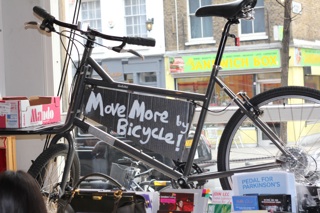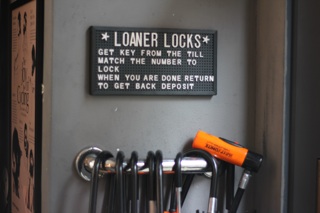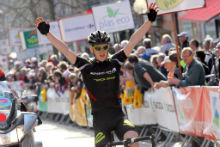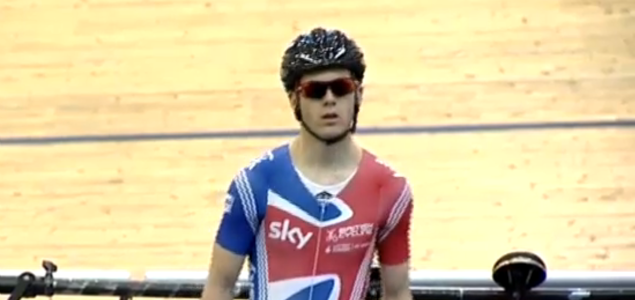Look Mum No Hands, a café on central London’s Old Street, has become a magnet for the capital’s cycling community.

Opened nearly two years ago by old friends and club cyclists, Lewin Chalkley, Matt Harper, and Sam Humpheson, LMNH has become a meeting place for cyclists and non-cyclists alike, an exhibition space for artists, a venue for book and product launches, and a screening room for cycling’s biggest races.
A thriving workshop, located in the café’s basement, and of course, a ready supply of food and drinks, completes the picture.
Frustrated at the absence of any public place to watch the key events on the calendar of professional cycling, the trio opened Look Mum No Hands nearly two years ago. The café’s success draws on the skills of each: Chalkley worked as a café manager, Humpheson was a mechanic at Sigma Sport, and Harper had worked in the City on the Swiss stock exchange (he reflects now that his former profession provided a quieter existence).

With Milan-San Remo only weeks away, the café will again become a place to watch the ‘monuments’ of the cycling calendar. April and May have become Humpheson’s favourite time of the year. “The spring Classics are great one day events. On Sunday afternoon, people come in for two or three hours, order lunch, and watch the race unfold. When you come here and do that, you realise cycling is a great sport to watch in a social environment. The races ebb and flow. There are sections where nearly nothing happens and people go and get coffees. You contrast that with five to 10 minutes of riveting action when no-one says a word. As the crowd loosens up, people start cheering and you’re looking at cycling in a way that’s totally different to sitting on your sofa watching Eurosport. You have 50 or 60 people in one room, all going for it together,” he says.
And while the Classics attract their share of weekend visitors, the three-week Grand Tours draw a daily crowd of hardcore followers. “The Tour is bonkers. It’s exciting and brilliant, but the Giro is has been incredible for the last two or three years,” Humpheson adds. “The Tour was quite successful for us. The Giro is more for the aficionado. One or two people came every day for two or three weeks. Goodness knows what they were supposed to be doing!”
Despite a core audience of cyclists, Harper expresses a strong belief in the café’s ‘open door’ policy and an absence of ‘cliquey-ness’. He says LMNH has no typical customer, with the clientele changing throughout the day and including students making the most of the café’s wi-fi, and business people, as well as cyclists.

Humpheson concurs: “Here it’s perfectly normal for someone to be sat at a table for a meeting and for someone in full lycra to be sat at the next table. There’s nothing unusual about riding a bike in London. Everyone should be riding a bike. London doesn’t make it easy to make that decision. You’re presented with problems. Simple things like off-street bike parking, and spare locks if someone has forgotten to bring their own, make this a very accessible place.
“We have got the physical features we need, but it’s as much an attitude as anything else. You can hang a picture of Eddy Merckx on the wall and say, ‘It’s a bike café, but don’t bring your bike in’. We didn’t want it to be a theme bar. We wanted it to go a little deeper than that,” he says.
The trio opened LMNH with little idea of the response they would receive. “There was nothing to compare it to,” says Harper. “Cyclists only gather at races. The only fixed place they had to go was the bike shop. It was difficult to know whether there was an appetite for something like this. All our forecasts went out the window within one month. It completely exceeded expectations. We had a launch and invited everyone we could think of. Everyone who came said they had heard about us and wanted to see what we would do. Cycling is a very tight community.”

He insists that LMNH succeeds first and foremost as a café. The hard work that goes into a seasonal menu, good coffee, and ‘smoothees’ is essential to attract customers of any background, he maintains. A varied menu of seasonal dishes includes staples such as pies (free range pork, sausage and mash among them) and salads (pasta and green). Typical specials include butternut squad stuffed with roast vegetables, baked aubergine, and courgette lasagne.
A staff of up to three mechanics works in the basement workshop from 7.30am to 8pm. “A lot of people who have got into road cycling work in central London or the West End,” says Humpheson. “People who want their race bike sorted will ride it here in the morning and leave it at the workshop. We don’t see many mountain bikes because we’re in the centre of town. We might have a Brompton in the stand, followed by something covered in Super Record. We embrace pretty much everything.”
Bare wooden tables and school room chairs give the café a functional aesthetic. Metal-framed window panes running the length of the café frontage flood the place with light. A constant stream of events and exhibitions provides a further attraction. Graeme Obree held a book signing at the café in January. An exhibition of photography by Emmanuel Benoit (portraits of the Eritrean national cycling team) opened yesterday, and a recent Rollapaluza roller racing event proved hugely successful. A bike jumble will be held this Sunday (4).




